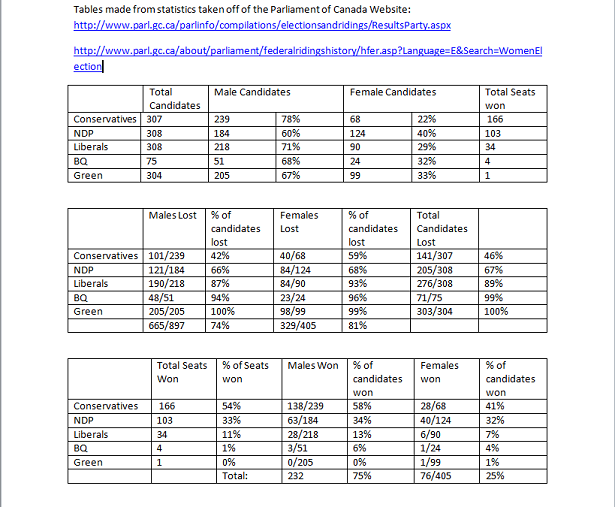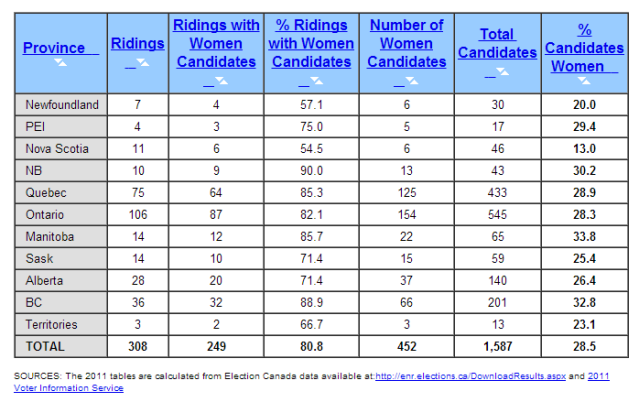
Not a very sexy table, but it serves its purpose.
Do women simply not get elected?
Here is a table of figures created for my term paper in my Canadian Politics class.
What this says to me is that the low representation of women in Canadian politics is not a matter of women being unpopular as candidates. This says to me that despite that overall disparity in representation (75% men and 25% women), the success rates of women are not a lot lower than men. This is particularly clear in the NDP, who had the largest proportion of female candidates. They lost 66% of their men and 68% of their women, and won 33% and 34%. In the parties with more female candidates, there wasn’t a voting preference for male candidates. Thus the issue of underrepresentative of women can be attributed in part to simply the lack of female candidates.
So getting to the root of the problem: the first past the post system. This system is known for creating majority governments because it amplifies the advantage of parties. How it works:
A candidate simply needs a plurality of the votes (not the majority) in order to gain office. This means that say in all 308 ridings the results are thus:
Conservatives 35%
Liberals 32%
NDP 28%
Green 5%
The majority of people in these three ridings voted against the Conservatives, 65%. But the Conservatives have 308 seats, or 100% because they received the most votes in all 308 ridings. The system inherently inflates the number of seats received by a party.
Now let’s look at it in terms of women.
Around 900 males ran for election while 400 women ran for election. There are only 308 ridings so that means that there are about 100 ridings with multiple women and 600 ridings with multiple men. That means, by the numbers, women are just less likely to be elected because there are less of them nominated in the first place. Only one candidate can win per riding, so if 3 male candidates and 1 female are running, she is more likely to be lost in the crowd, especially because there were more women in the parties that won less seats.
The Conservatives won the most seats, but had the least amount of women. Out of their 307 candidates, only 68 of them were women. That means that even if they won every single seat by the same margins that I presented above. Women would only occupy 68 of those seats while the men would have received 239. In contrast, the official opposition, the NDP had nominated 124 women candidates, increasing the likelihood of women being elected. However, as the election results stand, the Conservatives won the most seats, decreasing the likelihood of women’s election.
However, the fact that the party with the second most seats nominated so many female candidates speaks to why the 2011 election has been touted as the most successful for women to date. More women nominated, the more likely it is that they are elected.
The lack of women can also be attributed to ridings with a concentration of women, here is another area where female candidates can be lost because the system utilized many small races where one candidate comes out on top.
So we see the province with the most female candidates is Quebec. But there are 64 ridings, but 125 female candidates. That means that only 64 females can win out of 125 even if every single one of them win. And in total there are 249 ridings and 452 candidates, so we are losing around half the women no matter what the outcome.
Of course I acknowledge that these are the numbers from one single election cycle, but due to time constraints and the fact that I already spent like 3 hours playing with these numbers because I found it interesting, kind of limits me to just this election cycle.
The solution to this has been proposed by a lot of other people, particularly to resolve the issue the FTP system raises in terms of party representation.
Proportional representation. A list system with a quota, for example, can ensure that an equal amount women and men are being put forward and election.
Ex. Conservatives received 30% of the vote or 92 seats. Quota is set at 50% female. They can just fill seats half from a female list of candidates and a male list of candidate until there is gender parity.
*note I’ll probably be using a lot of this in my term paper so if the TA, for example, decides to do a google search and this comes up, I didn’t plagarize from myself: my full name is Wei-Ju Wang and this is for Luc Turgeon’s POL2101D
Was going to present counterargument, but I’m lazy and I should be writing my actual paper. So feel free to poke many holes in this post. Might post the other 2 sections of my essay which argue that women are less likely to nominate themselves and are less likely to be nominated. (This above only addresses the institutional causes of the underrepresentation of women. I hope that’s apparent, because I feel like I kind of just rambled for a bit.)
